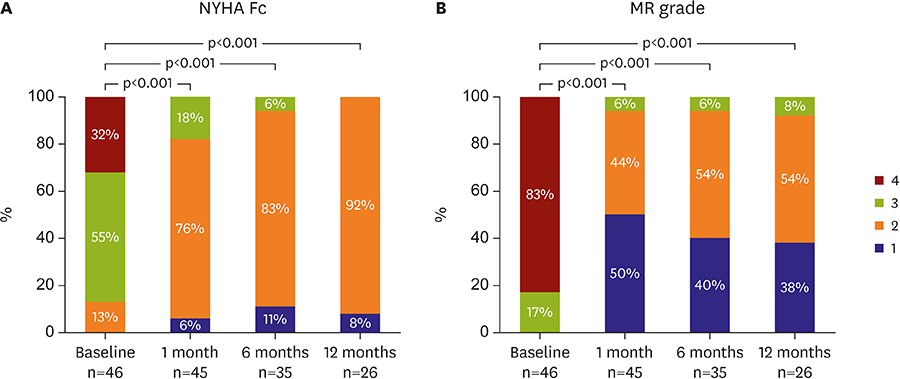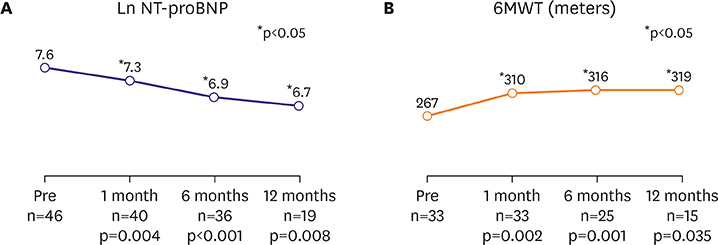Korean Circ J.
2019 Jun;49(6):532-541. 10.4070/kcj.2018.0417.
Can Elderly Patients with Severe Mitral Regurgitation Benefit from Trans-catheter Mitral Valve Repair?
- Affiliations
-
- 1Division of Cardiology, Department of Medicine, National Yang-Ming University, Taipei, Taiwan, R.O.C.
- 2Department of Medical Affairs and Planning, National Yang-Ming University, Taipei, Taiwan, R.O.C.
- 3Cardiovascular Research Center, National Yang-Ming University, Taipei, Taiwan, R.O.C.
- 4Institute of Health Policy and Management, College of Public Health, National Taiwan University, Taipei, Taiwan, R.O.C. kpchung@ntu.edu.tw
- 5Division of Cardiovascular Surgery, Department of Surgery, National Yang-Ming University, Taipei, Taiwan, R.O.C.
- KMID: 2454049
- DOI: http://doi.org/10.4070/kcj.2018.0417
Abstract
- BACKGROUND AND OBJECTIVES
Age is a traditional risk factor for open-heart surgery. The efficacy and safety of transcatheter edge-to-edge mitral valve repair, using MitraClip (Abbott Vascular), has been demonstrated in patients with severe mitral regurgitation (MR). Since octogenarians or older patients are usually deferred to receive open-heart surgery, the main interest of this study is to elucidate the procedural safety and long-term clinical impact of MitraClip in elderly patients.
METHODS
Patients with symptomatic severe MR were evaluated by the heart team. For those with high or prohibitive surgical risks, transcatheter mitral valve repair was performed in hybrid operation room. Transthoracic echocardiography (TTE), blood tests, and six-minute walk test (6MWT) were performed before, 1-month, 6-months, and 1 year after index procedure.
RESULTS
A total of 46 consecutive patients receiving MitraClip procedure were enrolled. Nineteen patients (84.2±4.0 years) were over 80-year-old and 27 (73.4±11.1 years) were younger than 80. Compare to baseline, the significant reduction in MR severity was achieved after the procedure and sustained. All the patients benefited from significant improvement in New York Heart Association functional class. The 6-minute walk test (6MWT) increased from 259±114 to 319±92 meters (p=0.03) at 1 year. The overall 1-year survival rate was 80% in the elderly and 88% in those <80 years, p=0.590. Baseline 6MWT was a predictor for all-cause mortality (odds ratio, 0.99; 95% confidence interval, 0.982-0.999; p=0.026) after the MitraClip procedure.
CONCLUSIONS
Trans-catheter edge-to-edge mitral valve repairs are safe and have positive clinical impact in subjects with severe MR, even in advanced age.
Keyword
MeSH Terms
Figure
Cited by 1 articles
-
Transcatheter Mitral Valve Repair: Growing Evidence Regarding It's Efficacy and Optimal Indication
Jah Yeon Choi, Geu-Ru Hong
Korean Circ J. 2019;49(6):542-544. doi: 10.4070/kcj.2019.0154.
Reference
-
1. Nkomo VT, Gardin JM, Skelton TN, Gottdiener JS, Scott CG, Enriquez-Sarano M. Burden of valvular heart diseases: a population-based study. Lancet. 2006; 368:1005–1011.
Article2. Coffey S, Cox B, Williams MJ. Lack of progress in valvular heart disease in the pre-transcatheter aortic valve replacement era: increasing deaths and minimal change in mortality rate over the past three decades. Am Heart J. 2014; 167:562–567.e2.
Article3. Goel SS, Bajaj N, Aggarwal B, et al. Prevalence and outcomes of unoperated patients with severe symptomatic mitral regurgitation and heart failure: comprehensive analysis to determine the potential role of MitraClip for this unmet need. J Am Coll Cardiol. 2014; 63:185–186.4. Mirabel M, Iung B, Baron G, et al. What are the characteristics of patients with severe, symptomatic, mitral regurgitation who are denied surgery? Eur Heart J. 2007; 28:1358–1365.
Article5. Nishimura RA, Otto CM, Bonow RO, et al. 2017 AHA/ACC focused update of the 2014 AHA/ACC guideline for the management of patients with valvular heart disease: a report of the American College of Cardiology/American Heart Association Task Force on Clinical Practice Guidelines. J Am Coll Cardiol. 2017; 70:252–289.6. Feldman T, Foster E, Glower DD, et al. Percutaneous repair or surgery for mitral regurgitation. N Engl J Med. 2011; 364:1395–1406.
Article7. Feldman T, Kar S, Elmariah S, et al. Randomized comparison of percutaneous repair and surgery for mitral regurgitation: 5-year results of EVEREST II. J Am Coll Cardiol. 2015; 66:2844–2854.8. Lee CW, Sung SH, Tsai YL, et al. Initial experience with percutaneous edge-to-edge transcatheter mitral valve repair in a tertiary medical center in Taiwan. J Chin Med Assoc. 2018; 81:305–310.
Article9. Lang RM, Bierig M, Devereux RB, et al. Recommendations for chamber quantification: a report from the American Society of Echocardiography's Guidelines and Standards Committee and the Chamber Quantification Writing Group, developed in conjunction with the European Association of Echocardiography, a branch of the European Society of Cardiology. J Am Soc Echocardiogr. 2005; 18:1440–1463.
Article10. Rudski LG, Lai WW, Afilalo J, et al. Guidelines for the echocardiographic assessment of the right heart in adults: a report from the American Society of Echocardiography endorsed by the European Association of Echocardiography, a registered branch of the European Society of Cardiology, and the Canadian Society of Echocardiography. J Am Soc Echocardiogr. 2010; 23:685–713.11. Zoghbi WA, Enriquez-Sarano M, Foster E, et al. Recommendations for evaluation of the severity of native valvular regurgitation with two-dimensional and Doppler echocardiography. J Am Soc Echocardiogr. 2003; 16:777–802.
Article12. Zoghbi WA, Adams D, Bonow RO, et al. Recommendations for noninvasive evaluation of native valvular regurgitation: a report from the American Society of Echocardiography Developed in Collaboration with the Society for Cardiovascular Magnetic Resonance. J Am Soc Echocardiogr. 2017; 30:303–371.13. Enriquez-Sarano M, Akins CW, Vahanian A. Mitral regurgitation. Lancet. 2009; 373:1382–1394.
Article14. Stone GW, Adams DH, Abraham WT, et al. Clinical trial design principles and endpoint definitions for transcatheter mitral valve repair and replacement. Part 2. Endpoint definitions: a consensus document from the Mitral Valve Academic Research Consortium. J Am Coll Cardiol. 2015; 66:308–321.15. Nickenig G, Estevez-Loureiro R, Franzen O, et al. Percutaneous mitral valve edge-to-edge repair: in-hospital results and 1-year follow-up of 628 patients of the 2011–2012 Pilot European Sentinel Registry. J Am Coll Cardiol. 2014; 64:875–884.16. Roques F, Michel P, Goldstone AR, Nashef SA. The logistic EuroSCORE. Eur Heart J. 2003; 24:881–882.
Article17. Nashef SA, Roques F, Sharples LD, et al. EuroSCORE II. Eur J Cardiothorac Surg. 2012; 41:734–744.
Article18. Andalib A, Mamane S, Schiller I, et al. A systematic review and meta-analysis of surgical outcomes following mitral valve surgery in octogenarians: implications for transcatheter mitral valve interventions. EuroIntervention. 2014; 9:1225–1234.
Article19. Buzzatti N, Maisano F, Latib A, et al. Comparison of outcomes of percutaneous MitraClip versus surgical repair or replacement for degenerative mitral regurgitation in octogenarians. Am J Cardiol. 2015; 115:487–492.
Article20. Scandura S, Capranzano P, Caggegi A, et al. Percutaneous mitral valve repair with the MitraClip system in the elderly: one-year outcomes from the GRASP registry. Int J Cardiol. 2016; 224:440–446.
Article21. Uchmanowicz I, Gobbens RJ. The relationship between frailty, anxiety and depression, and health-related quality of life in elderly patients with heart failure. Clin Interv Aging. 2015; 10:1595–1600.
Article22. Metze C, Matzik AS, Scherner M, et al. Impact of frailty on outcomes in patients undergoing percutaneous mitral valve repair. JACC Cardiovasc Interv. 2017; 10:1920–1929.23. Ledwoch J, Franke J, Lubos E, et al. Prognostic value of preprocedural 6-min walk test in patients undergoing transcatheter mitral valve repair-insights from the German transcatheter mitral valve interventions registry. Clin Res Cardiol. 2018; 107:241–248.
Article24. Zhang GX, Wang C, Wang L, et al. Validation of EuroSCORE II in Chinese patients undergoing heart valve surgery. Heart Lung Circ. 2013; 22:606–611.
Article25. Wang C, Tang YF, Zhang JJ, et al. Comparison of four risk scores for in-hospital mortality in patients undergoing heart valve surgery: a multicenter study in a Chinese population. Heart Lung. 2016; 45:423–428.
Article26. Puls M, Lubos E, Boekstegers P, et al. One-year outcomes and predictors of mortality after MitraClip therapy in contemporary clinical practice: results from the German transcatheter mitral valve interventions registry. Eur Heart J. 2016; 37:703–712.
Article27. Buccheri S, Capodanno D, Barbanti M, et al. A risk model for prediction of 1-year mortality in patients undergoing MitraClip implantation. Am J Cardiol. 2017; 119:1443–1449.
Article28. Maisano F, Franzen O, Baldus S, et al. Percutaneous mitral valve interventions in the real world: early and 1-year results from the ACCESS-EU, a prospective, multicenter, nonrandomized post-approval study of the MitraClip therapy in Europe. J Am Coll Cardiol. 2013; 62:1052–1061.29. Scholtz S, Dimitriadis Z, Vlachojannis M, et al. Transcatheter aortic valve implantation in nonagenarians: procedural outcome and mid-term results. Heart Lung Circ. 2018; 27:725–730.
Article
- Full Text Links
- Actions
-
Cited
- CITED
-
- Close
- Share
- Similar articles
-
- Mitral Valve Repair
- Congenital Double-Orifice Mitral Valve with Mitral Valve Prolapse and Severe Mitral Regurgitation
- Echocardiographic Assessment of Mitral Valve Regurgitation
- Mitral Valve Repair for Barlow’s Disease with Mitral Annular and Subvalvular Calcification: A Case Report
- Single-Suture Neochorda-Folding Plasty for Mitral Regurgitation





